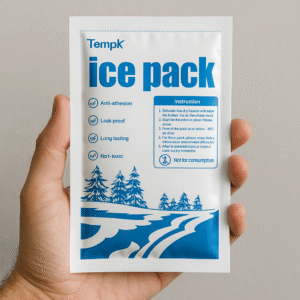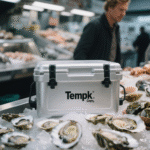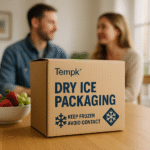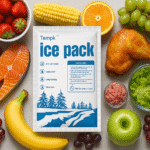1) What dry ice is—and why it matters in emergencies
Dry ice is solid CO₂ (UN 1845) at about –78.5 °C (–109 °F). As it warms, it sublimates—jumping straight from solid to gas. That’s perfect for emergency cooling (no meltwater mess) and long‑haul cold‑chain—but it also means rapid gas build‑up if you trap it. One pound becomes ~250 liters of CO₂, so ventilation is mandatory.
From a health & safety perspective, plan to stay well below common occupational thresholds (5,000 ppm TWA; 30,000 ppm STEL) and never ride or work in small spaces with active sublimation without airflow.
2) Safety first: 10 non‑negotiables
-
Vent, don’t seal. Packaging must allow CO₂ to escape (loose‑fitting lid, vent plugs, etc.).
-
No airtight coolers/rooms/vehicles. CO₂ can displace oxygen. Monitor where practical.
-
Gloves/tongs & eye protection. Contact can cause instant frost injury.
-
Keep away from children/pets. Treat as an industrial refrigerant.
-
Do not put in glass/sealed jars. Pressure can burst containers.
-
Transport upright; secure loads. Label outside; keep in ventilated cargo area.
-
No sink, toilet, or trash disposal. Let it evaporate outdoors in a ventilated place.
-
Carbon‑steel shears for portioning; don’t chisel with kitchen knives.
-
Never touch edible product directly (freezer burn risk); use liners/cardboard standoffs.
-
Know your local rules (airport, courier, USPS) before you move anything.
3) Power outage playbook (food & home)
How long is food safe without power?
-
Refrigerator: ≈ 4 hours (doors closed).
-
Freezer: ≈ 48 hours full (24 hours half‑full).
These are baseline public‑health timelines—use an appliance thermometer and keep doors shut.
Extending time with dry ice (rule‑of‑thumb)
-
18 ft³ freezer: ~50 lb dry ice ≈ 2 days of hold time (with doors closed).
-
For general planning in outages, a common guidance is ~2.5–3 lb per cubic foot of freezer space. Place slabs on the top shelf (CO₂ sinks; cold drops).
Placement tips
-
Chest freezers: lay cardboard over food, then the dry ice on top.
-
Upright freezers: split slabs across shelves to avoid warm pockets.
-
Ventilate the room; crack a window if safe.
When to discard
If refrigerated perishables exceed 40 °F (4 °C) for >2 hours, discard. Don’t taste to check; when in doubt, throw it out.
4) Medical & lab cold chain (vaccines, ULT, specimens)
-
Do not use dry ice to hold 2–8 °C vaccines. It can freeze and damage many vaccines—CDC explicitly cautions against dry ice for refrigerator‑range products.
-
ULT shipments are in scope (2025): WHO’s 7th edition (2025) Guidelines for the international packaging and shipping of vaccines adds dedicated guidance for ultra‑cold chain shipments. Use manufacturer‑approved ULT shippers and data loggers.
-
Specimens on dry ice: multi‑layer (triple) packaging; no direct contact between dry ice and the primary container; surround the secondary with dry ice and absorbent.
5) 2025 shipping rules: air, courier & mail
A) Air cargo (IATA DGR 66th edition, effective Jan 1, 2025)
For Dry ice (Carbon dioxide, solid), UN 1845 packaged by itself or with non‑dangerous goods:
-
Air Waybill (AWB) must show: UN1845, proper shipping name (“Dry ice”/“Carbon dioxide, solid”), number of packages, and net weight of dry ice (kg).
-
Packaging must be vented; Class 9 label required; irrelevant marks removed.
-
Quantity per package: ≤200 kg.
-
Overpacks: either show all marks/labels through or mark “OVERPACK” and add the total net dry‑ice weight on the overpack.
-
State/operator variations apply—check your airline’s technical manual.
Pro tip: If the consignment contains infectious substances (e.g., UN3373, Category B), you must add the infectious‑substance markings/labels per IATA—and still mark dry ice as UN1845 with the net weight. CDC reiterates the Class 9 + UN1845 + net weight requirement when dry ice is present.
B) U.S. mail (USPS)
-
Domestic air: per Packaging Instruction 9A, each mailpiece may contain no more than 5 lb of dry ice; packaging must vent CO₂; follow 49 CFR 173.217. International mailing with dry ice is generally not permitted.
C) Passenger travel (carry‑on/checked)
-
Up to 2.5 kg (5.5 lb) per passenger if the package vents CO₂ and is properly marked (“Dry ice”/“Carbon dioxide, solid” + net weight or indication ≤2.5 kg). Check airline rules before you fly.
D) U.S. ground (DOT)
-
Packaging must permit gas release—do not seal dry ice in airtight containers.
-
Placards: For domestic highway transport, a Class 9 placard is generally not required; however, other Table 2 thresholds and bulk‑package ID number rules apply. Review 49 CFR 172.504 before dispatch.
6) How to pack (step‑by‑step)
6.1 For e‑commerce or home: dry ice pack for shipping food
Goal: keep frozen solid for 24–48 h with carrier handling.
-
Choose the shipper: rigid foam‑lined corrugated or molded EPS/poly with tight (not airtight) lid.
-
Pre‑chill everything. Freeze items to ≤ –18 °C; pre‑chill gel packs (for buffer zones).
-
Line & separate: cardboard layer above products to avoid freezer burn.
-
Add dry ice: place slabs/pellets on top of the product layer so cold air sinks; leave vent path.
-
Fill voids to reduce air volume (paper, foam)—less air = slower sublimation.
-
Close loosely/vent path guaranteed. Tape the outer carton only; never hermetically seal the inner.
-
Mark & label: “Dry ice” or “Carbon dioxide, solid” + UN 1845 + net dry‑ice weight (kg); add Class 9 label as required by the carrier mode.
-
Documentation: include UN1845 line on AWB if by air (see Section 5A).
USPS note: domestic air ≤5 lb per mailpiece; check PI 9A for exact marking text and carton ventilation.
6.2 Patient specimens (frozen)
-
Primary (sealed, leak‑proof).
-
Secondary (watertight + absorbent).
-
Outer (rigid, insulated).
-
Dry ice around the secondary, not touching the primary; secure to prevent shifting.
-
Marking/labels: infectious substance requirements as applicable plus dry ice UN 1845 + net weight.
6.3 ULT/vaccine kits (manufacturer shippers)
-
Only use manufacturer‑approved shippers and continuous monitoring (data logger).
-
Follow WHO 7th ed (2025) guidance for packaging and documentation; never swap components (e.g., unfamiliar vents/absorbers).
7) How much dry ice do I need? (Quick sizing)
-
Outage: plan ~2.5–3 lb per ft³ of freezer space for ≈ 48 h stabilization (doors closed).
-
Parcel shipments: a common field range is ~5–10 lb per 24 h for a rigid cooler, depending on insulation and ambient temps. Start at the high end for summer lanes and down‑spec after lane validation with loggers. (Ranges are empirical; validate in your packaging qualification.)
Engineering note: packaging design, fill ratio, ambient, and handling dramatically affect sublimation—verify with a lane trial and a temperature logger.
8) FAQ
Is dry ice food‑safe?
Yes—CO₂ itself is food‑contact safe, but do not place slabs directly on foods you don’t want frozen; use cardboard/liners.
Can I put dry ice in drinks?
No. Ingestion/contact can injure tissue; use standard ice for beverages.
How do I dispose of leftovers?
Let it sublimate outdoors or in a well‑ventilated area, away from people/pets.
Can I mail dry ice internationally with USPS?
No—USPS allows domestic dry‑ice shipments with strict limits (≤5 lb air per piece).
How much dry ice can I carry on a plane?
Generally 2.5 kg (5.5 lb) per passenger if packaged to vent CO₂ and properly marked—always confirm airline rules.
Do I need hazmat placards for a vanload of dry‑ice parcels?
For domestic U.S. highway moves, a Class 9 placard isn’t required in most cases; bulk ID and other Table 2 rules may still apply. Check 49 CFR 172.504 and your specific configuration.
9) Printable compliance checklist (shipments with dry ice)
-
☐ Package vents CO₂; no airtight seals (49 CFR 173.217).
-
☐ Marking on each package: “Dry ice” or “Carbon dioxide, solid” + UN 1845 + net dry‑ice weight (kg).
-
☐ Class 9 label applied and unobscured; irrelevant marks removed.
-
☐ AWB shows UN1845, name, package count, net dry‑ice weight (if by air).
-
☐ Overpack: “OVERPACK” if inner marks aren’t visible; show total net dry‑ice weight.
-
☐ State/operator variations reviewed (airline rules).
-
☐ USPS: domestic only; ≤5 lb per mailpiece by air; follow PI 9A.
-
☐ Vaccines: no dry ice for 2–8 °C storage; ULT kits per WHO 7th ed (2025
























